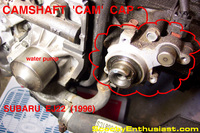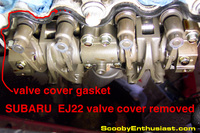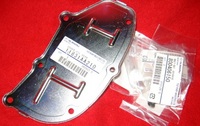SUBARU Engine Oil Leak Causes and Repair
Described here are the most common causes of SUBARU engine oil leaks.
View the entire photo gallery of SUBARU engine oil leak sources here.
SUBARU Front camshaft oil seals oil leak
Note: The front camshaft oil seal leak information applies only to Subaru engines with a timing belt such as the 1.8L EJ18, 2.2L EJ22, 2.5L EJ25. Does not apply to the H6 EZ30 which uses a timing chain).
The front camshaft seals are behind the camshaft sprockets. The camshaft sprockets are behind the timing belt cover. These oil seals can leak with age and mileage, especially the earlier black colored seals. The later brown colored seals are more resilient.
The smart time to replace the front cam seals is when the timing belt it is changed, since much of the labor involved in replacing these oil seals involves the R&R (removal&reinstallation) of the timing belt.
On the SOHC (single overhead cam) engines, there are two if these front camshaft oil seals. On DOHC (double overhead cam) engines, there are four of these oil seals. The front cam seals live behind the camshaft sprockets. The sprockets must be removed to replace the seals. The photos below are of the SOHC variety (specifically the EJ22):
SUBARU Front crankshaft 'crank' seal oil leak
The front crankshaft seal is mounted on the oil pump. The oil pump is turned by the crankshaft. The front crank oil seal is smart to replace when replacing the timing belt. Resealing the oil pump is the wise way go since there are other things about the oil pump that can leak, namely the rear rotor case cover screws backing out.
SUBARU Camshaft 'cam' cap o-rings oil leak
 These o-rings are located behind the LH (left-hand) cam cap (on the sohc 2.2L and 2.5L anyway). This o-ring can get squashed and brittle with time and potentially allow a leak. The smart time to replace this o-ring is when replacing the timing belt. To replace it, the camshaft sprocket must be removed.
These o-rings are located behind the LH (left-hand) cam cap (on the sohc 2.2L and 2.5L anyway). This o-ring can get squashed and brittle with time and potentially allow a leak. The smart time to replace this o-ring is when replacing the timing belt. To replace it, the camshaft sprocket must be removed.
Also, EJ22 engines have a cam cap at the RH (right-hand) side rear of the engine. This cap also has an o-ring that can leak oil. (On SUBARU EJ22T (turbocharged) engines, the turbo oil return goes into this area).
SUBARU Valve cover gaskets oil leak
 These gaskets seal the valves covers against the mating surface cylinder head. They can shrink or crack with age and then result in an oil leak. The oil in this area is not under pressure as it is on its way to draining back to the oil pan.
These gaskets seal the valves covers against the mating surface cylinder head. They can shrink or crack with age and then result in an oil leak. The oil in this area is not under pressure as it is on its way to draining back to the oil pan.
Sometimes the valve cover bolts loosen slightly and can allow oil to leak past the gaskets. There are also bolt sealing washers that should be replaced if replacing the valve cover gaskets. A kit is available from Subaru dealers containing the needed valves cover gaskets and bolt hole seals.
If the spark plug tubes on your soob engine penetrate the valve cover (such as on the EJ25 sohc), you should also replace the spark plug tube seals.
SUBARU Spark plug tube seals oil leak
Spark plug tube seals Subaru oil leak[/h3] If the spark plug tubes penetrate the valve covers on your soob engine (such as EJ25 sohc phase II), these seals can shrink with time and allow oil to seep past and down into the spark plug tubes.
If you see an excessive amount of oil in the spark plug tubes when replacing the spark plugs, then these spark plug tube seals probably need to be replaced. If too much oil accumulates in the spark plug tubes, it can result in cylinder misfire from the oil diverting the spark energy.
Cylinder misfire typically shows up as a flashing CEL (check engine light) (aka MIL - malfunction indicator lamp). If the codes are read typically P0301, P0302, P0303 and/or P0304 are read.
SUBARU Oil separator plate oil leak
 This plate is at the rear of the engine. It provides a hand hole for access during certain engine repair jobs. Many SUBARU engines came from the factory with a plastic oil separator plate. These plates can then start to leak with age and mileage.
This plate is at the rear of the engine. It provides a hand hole for access during certain engine repair jobs. Many SUBARU engines came from the factory with a plastic oil separator plate. These plates can then start to leak with age and mileage.
The solution is an upgraded metal oil separator plate with new screws. Unfortunately, the engine or transmission must be removed to gain access to replace this plate. So unless the engine is really gushing oil it may not be practicable to replace the oil separator plate.
However, if the engine or transmission is pulled for some other reason (clutch replacement, head gasket replacement, etc), then it is definitely prudent to replace the separator plate with the upgraded metal version at that time.
If you have questions or comments, please feel free to post a comment below, or visit the SUBARU repair forum.
About the Author
This article was written by Lewis Werner. It was last updated June 10, 2011 and first published November 12, 2010. If you have questions about the article, please click here to view the author's contact information including e-mail address, telephone number and mailing address.
my mechanic recently converted my 1985 vw vanagon with a 2.2L Subaru Engine. The engine is running strong, however, I'm having to replace about 3/4 Qt every time I fill the gas tank. There is no evidence of oil leak at rest/no oil collection under the car. How do I know if it is burning oil or if I need to replace the oil seals (main seal is already done)? Thanks, Chris
Hello Chris. That sounds like a nice VW conversion project! I would check the PCV valve. It screws into the top of the intake manifold near the coil pack. Sometimes if it is gummed up or not working properly, it can cause excess oil consumption. Especially if you're not seeing the oil leaking out anywhere. Of course poor ring seal or other internal engine issues could cause excess oil consumption as well, but the PCV valve is going to be a relatively inexpensive thing to check/replace. If I remember correctly a 22mm or 7/8" deep socket is the easiest way to get it out. Please let me know if you have any other questions!
Hard to lose some oil in the engine! Some gaskets are just way to brittle when it ages. The oil pan gasket of my car was replaced because it was leaking oil too much and make me wipe the floor every morning. Other than that I need to frequently check the oil level and peridically pour oil.
Hey Lewis, Thanks for posting this thread. I have now replaced the rear main seal a second time after 215,000 miles and a slight leak after the engine warms up. Both times the oil leak ended up being ten times worse. I am puzzled to say the least about this as I found no "damage" to the seal when I pulled the motor for just that reason. Any suggestions/answers I would appreciate and If there is anything I have left out let me know please. James
That being said, replacing the rear main seal on Subaru cars is tricky. The new seal has to be installed absolutely perfectly, or it will often leak worse than the original. I have heard many seasoned Subaru enthusiasts say they never touch the rear main seal unless it is really gushing because usually the replacement ends up leaking worse.
Are you using a genuine Subaru seal? Sometimes aftermarket seals do not work as well as the original.
You probably already checked it, but is it possible the crankshaft got gouged when removing the old seal and it is ripping the new seal?
Wow! Lewis thanks for your quick response! I used factory materials both time and I guess those "seasoned" guys may be on to something. I have read quite a few web surfers and Subaru owners talk about the smell when oil is dripping/has dripped on hot exhaust pipes and thats what I had. I had checked both the sealing surface on the block and the crank for scoring/roughness. There was no indications of a problem and as far as that goes I found no problem with the first new seal that I had removed from the first replacement. The install the first time seemed to go well, I used a seal driver and all. The second replacement was just as bad as far as spewing oil out the back of the motor. As I mentioned I am puzzled to say the least. I have real good experience yanking that motor out now and it appears that I have yet again to perform the same thing. I had hoped for possibly some unknown trade secret that I was overlooking or something. Hey I do appreciate your feedback and quite honestly I really like this car and hope to drive it again someday!
Hello James, thanks for getting back to me. It sounds like you did all you could to install the new Subaru rear main seal properly. I'm sorry to hear it is still leaking like that. But like you said, it does give some good experience with removing and reinstalling the Subaru engine! I do not know of any other tricks to get the rear main seal installed properly. It seems people say it has to be perfectly even and flush when it installed, or it will leak, and that it is very difficult even with a good seal driver to get the Subaru rear main seal installed perfectly evenly.
I am surprised to hear about rear main seal leaks. Never seen one leak. Did dozens of those on JDM engines with perfect seals, still replaced them anyway. It's easy to remove with a flat screwdriver. I clean inside well and tap it in with primitive home made drift, doesn't have to be perfect or flush except too crooked or going too far in. Must be the OEM viton (brown) seal. Subaru used black seals on older engines, they leak. The only oil drip usually comes from plastic oil separator covers. Always replace with metal one, old aluminum or new steel. Leon
Hello Leon. Thank you for sharing your experience with the Subaru rear main seals on the JDM engines. I've seen the old black seals leak quite a bit too, usually on the camshafts.